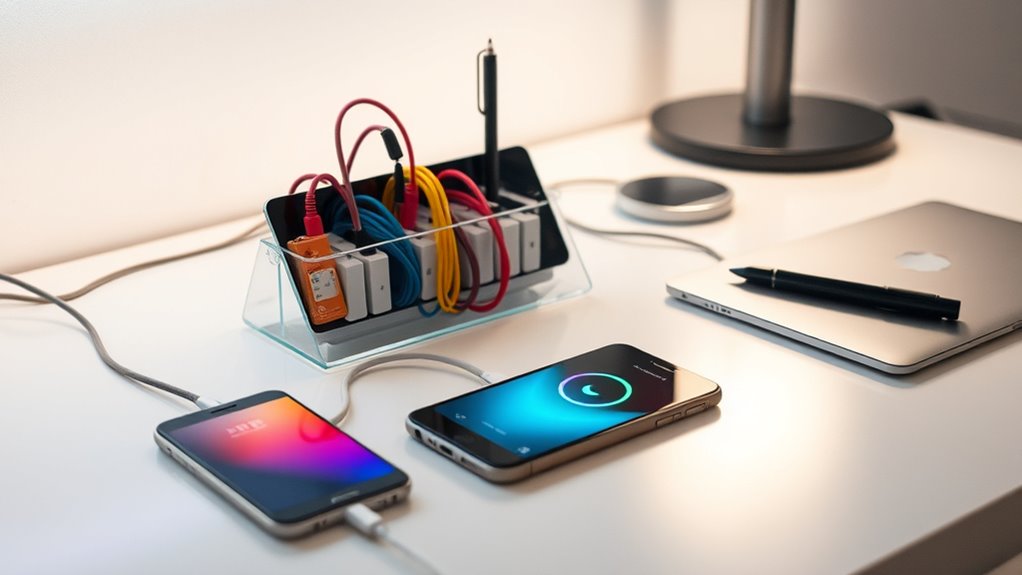To manage your electronics effectively, adopt smart charging habits by avoiding overcharging and using quality cables, while keeping devices in moderate temperature. Sync your data regularly with secure cloud services and back up important files. Keep your software updated for performance and security. Monitor battery health and optimize settings like brightness and background activity to extend device life. By applying these practices, you’ll improve your device’s longevity and reliability—continue exploring for more helpful tips.
Key Takeaways
- Use quality chargers and cables, and avoid extreme temperatures to protect battery health during charging.
- Enable automatic syncing and cloud backups to ensure seamless data access and safeguard information.
- Keep device software updated regularly to improve performance, security, and battery efficiency.
- Maintain battery levels between 20% and 80% to extend battery lifespan and prevent overcharging.
- Monitor and manage app background activity and screen brightness to conserve battery and optimize device performance.

In today’s digital age, managing your electronics effectively is crucial to stay organized, protect your devices, and prolong their lifespan. Proper management starts with understanding how to optimize your battery life, which is essential for maintaining device performance over time. Battery optimization involves more than just avoiding overcharging; it also requires you to pay attention to your device’s settings. For example, enabling power-saving modes when your battery is running low can greatly extend usage time. Limiting background activity for apps and reducing screen brightness are simple yet effective steps. Keep an eye on your battery health through device settings or dedicated apps, and avoid letting your battery drain completely or stay at 0% for long periods, as this can degrade its capacity. Additionally, software updates play a critical role in maintaining your device’s health. Regularly updating your operating system and apps ensures you benefit from the latest performance improvements, security patches, and bug fixes. These updates often include enhancements that improve battery efficiency, helping your device run longer between charges. Neglecting software updates can lead to performance issues and even security vulnerabilities, which might compromise your data and device integrity. When updating, ensure your device is connected to a reliable power source and has sufficient storage space to avoid interruptions. Managing your data and syncing your devices also contributes to smoother operation and better organization. Properly syncing your phone, tablet, or laptop with cloud services or other devices allows you to access your files seamlessly across platforms. Regular backups safeguard your data against accidental loss or device failure. When syncing, choose secure methods and be mindful of privacy settings, especially when handling sensitive information. Charging habits also play a part in managing your electronics effectively. Avoid constantly topping off your battery at 100%, as this can strain the battery over time. Instead, aim to keep your charge levels between 20% and 80% whenever possible. Use quality chargers and cables, and avoid charging your device in extreme temperatures, which can affect battery health. Remember, maintaining good charging practices, combined with timely software updates and battery optimization, extends the lifespan of your devices and ensures they perform reliably when you need them most. Staying proactive in managing your electronics helps you avoid unnecessary repairs, data loss, and performance hiccups, making your digital life more efficient and secure. Additionally, understanding the importance of high refresh rates and low input lag in your devices can significantly improve your overall experience, especially during gaming or fast-paced multimedia activities.
Frequently Asked Questions
How Can I Extend My Electronic Device’s Battery Lifespan Effectively?
To extend your device’s battery lifespan, regularly perform battery calibration by fully charging and then draining it occasionally. Use power management features like dimming your screen and closing unused apps to reduce unnecessary drain. Avoid letting the battery completely die or stay fully charged for long periods. These habits help maintain ideal battery health, ensuring your device stays powered longer over time.
What Are the Best Practices for Safely Cleaning Charging Ports?
Imagine your charging port as a tiny gateway—keep it clear for smooth connections. To clean it safely, use dust removal tools like a soft brush or compressed air. Gently remove dust and debris without poking or forcing anything inside. Avoid harsh liquids or sharp objects, which can damage delicate components. Regular cleaning with proper tools guarantees your device charges properly and stays in top shape, extending its lifespan.
How Do I Troubleshoot Syncing Issues Between Devices?
To troubleshoot syncing issues between devices, start by checking your wireless synchronization settings to guarantee they’re enabled. Restart both devices to resolve minor glitches. If problems persist, update the troubleshooting software glitches on each device, as outdated software can cause sync failures. Make sure your devices are within range and connected to a stable network. Finally, try re-pairing the devices or resetting sync settings to restore proper communication.
Can Using Third-Party Chargers Damage My Electronics?
Sure, third-party chargers might seem tempting, but they can be the villains in your device’s story. Using incompatible chargers risks damaging your electronics, causing overheating, or even fried circuits. Stick to trusted brands and check device compatibility—your gadgets will thank you. After all, a cheap thrill isn’t worth a costly repair. Play it safe, and keep your electronics happy, healthy, and well-charged.
What Are the Signs of a Failing Charging Cable or Port?
You’ll notice a failing charging cable or port if your device charges intermittently, takes longer than usual, or doesn’t charge at all. Look for signs like frayed cable durability or bent connectors. Port corrosion can cause poor contact, leading to charging issues. If you see corrosion, debris, or loose connections, it’s time to replace the cable or have the port checked to prevent further damage.
Conclusion
So, here you are, master of your gadgets—charging, syncing, and managing data like a pro. Who would’ve thought that staying organized with your electronics might be the secret to a less chaotic life? Ironically, the more you try to control your devices, the more they seem to surprise you. But don’t worry—you’ve got this. Just keep charging, syncing, and backing up, and maybe, just maybe, your devices won’t turn against you when you least expect it.









